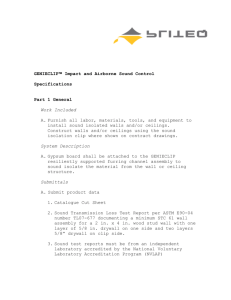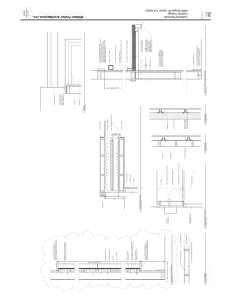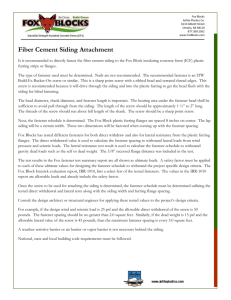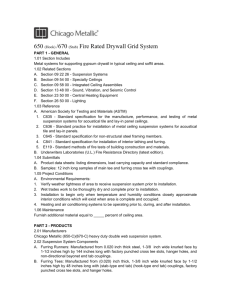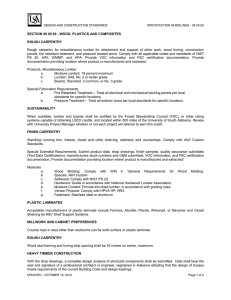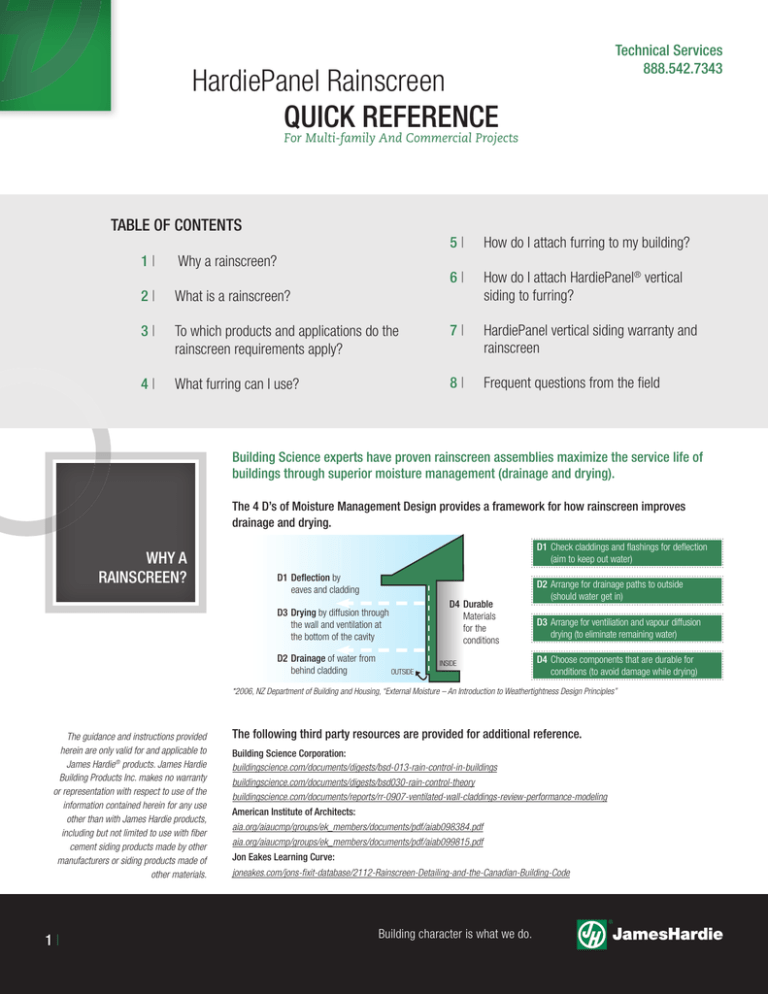
Technical Services
888.542.7343
HardiePanel Rainscreen
QUICK REFERENCE
For Multi-family And Commercial Projects
TABLE OF CONTENTS
5|
How do I attach furring to my building?
6|
How do I attach HardiePanel® vertical
siding to furring?
1|
Why a rainscreen?
2|
What is a rainscreen?
3|
To which products and applications do the
rainscreen requirements apply?
7|
HardiePanel vertical siding warranty and
rainscreen
4|
What furring can I use?
8|
Frequent questions from the field
Building Science experts have proven rainscreen assemblies maximize the service life of
buildings through superior moisture management (drainage and drying).
The 4 D’s of Moisture Management Design provides a framework for how rainscreen improves
drainage and drying.
WHY A
RAINSCREEN?
D1 Check claddings and flashings for deflection
(aim to keep out water)
D1 Deflection by
eaves and cladding
D4 Durable
Materials
for the
conditions
D3 Drying by diffusion through
the wall and ventilation at
the bottom of the cavity
D2 Drainage of water from
behind cladding
INSIDE
OUTSIDE
D2 Arrange for drainage paths to outside
(should water get in)
D3 Arrange for ventiliation and vapour diffusion
drying (to eliminate remaining water)
D4 Choose components that are durable for
conditions (to avoid damage while drying)
*2006, NZ Department of Building and Housing, “External Moisture – An Introduction to Weathertightness Design Principles”
The guidance and instructions provided
herein are only valid for and applicable to
James Hardie® products. James Hardie
Building Products Inc. makes no warranty
or representation with respect to use of the
information contained herein for any use
other than with James Hardie products,
including but not limited to use with fiber
cement siding products made by other
manufacturers or siding products made of
other materials.
1|
The following third party resources are provided for additional reference.
Building Science Corporation:
buildingscience.com/documents/digests/bsd-013-rain-control-in-buildings
buildingscience.com/documents/digests/bsd030-rain-control-theory
buildingscience.com/documents/reports/rr-0907-ventilated-wall-claddings-review-performance-modeling
American Institute of Architects:
aia.org/aiaucmp/groups/ek_members/documents/pdf/aiab098384.pdf
aia.org/aiaucmp/groups/ek_members/documents/pdf/aiab099815.pdf
Jon Eakes Learning Curve:
joneakes.com/jons-fixit-database/2112-Rainscreen-Detailing-and-the-Canadian-Building-Code
Building character is what we do.
Technical Services
888.542.7343
A rainscreen is an exterior cladding system featuring an air gap between the exterior
cladding and the water-resistive barrier. The air gap is created by vertical furring attached to the
wall, with the cladding fastened to framing or nailable substrate*, through the furring. James Hardie
requires the drainage and ventilation cavity (air gap) to be 3/8 in. (10 mm) or greater.
WHAT IS A
RAINSCREEN?
HardiePanel® Vertical Siding
OUTSIDE CORNER
-RAINSCREEN
FURRING
WOOD RAINSCREEN
FURRING
MIN)MIN.)
(3/8"
(3/8 THICK
IN. THICK
RAINSCREEN AIR SPACE
FIGURE 1
WATER RESISTIVE BARRIER
(HardieWrap™
Equivalent)
(HardieWrap® or
weather
barrier or equivalent)
EXTERIOR SHEATHING
HORIZONTAL BREAK AT FLOOR
TRANSITION - RAINSCREEN
S.A.F. MEMBRANE
FIGURE 2
HardiePanel ® Vertical Siding
HardiePanel® Siding
0
2"
4"
WATER RESISTIVE BARRIER
(HardieWrap™
or Equivalent)
(HardieWrap® weather
barrier or equivalent)
SCALE: 1" = 4"
EXTERIOR SHEATHING
* NAILABLE SUBSTRATE. The IRC defines a Nailable Substrate as a product or
material such as framing, sheathing, or furring, composed of wood or woodbased materials, or other materials and fasteners, providing equivalent fastener
withdrawal resistance under transverse load.
WOOD RAINSCREEN
FURRING
FURRING
MIN)
(3/8" THICK
(3/8
in. THICK
MIN.)
INSTALL BUG SCREEN
AS NECESSARY
3/8 MIN.
in. MIN.
CAULK)¹
3/8"
GAPGAP
(DO(DO
NOTNOT
CAULK)
Z-FLASHING
DETAIL:
NOTE: Rainscreen CAD details can
® be found at JamesHardieCommercial.com
Panel
1.04a
HardiePanel Vertical Siding Details
• Wood Framing with Wood Furring Strips
• OSB or Plywood Sheathing
Last Updated: 2013 August
¹ NOTE:
3/8MINIMUM
IN. MIN.GAP
GAP IS
IS RECOMMENDED
RECOMMENDED TO
TO
NOTE:
3/8"
ACCOUNT FOR STRUCTURAL MOVEMENT
BETWEEN FLOOR JOINTS. 1/4" MINIMUM
CLEARANCE IS REQUIRED BETWEEN
PANEL HORIZONTALS IN DIRECT TO
APPLICATIONS.
OPTIONAL DECORATIVE BAND
BOARD W/ EXTENDED Z-FLASH
NOTE: EVERY OTHER FLOOR BREAK SHALL
SHOULD
HAVE Z-FLASHING EXTENDING BACK TO
THE WEATHER
BARRIER.
WATER RESISTIVE BARRIER
0
2"
SCALE: 1" = 4"
HORIZONTAL BREAK @ FLOOR TRANSITION– RAINSCREEN
Building character is what we do.
2|
DETAIL:
®
4"
Technical Services
888.542.7343
RAINSCREEN
REQUIREMENTS
APPLY TO...
TO WHICH PRODUCTS AND APPLICATIONS DO THE RAINSCREEN REQUIREMENTS APPLY?
All James Hardie panel cladding products, including HardiePanel® vertical siding, Cempanel® vertical
siding, and Prevail™ Panel, require a rainscreen (3/8 inch air gap behind the cladding) when installed
on multi-family or commercial projects under any of the conditions listed below:
1 | Exterior walls without eave overhangs; or
2 | Exterior walls that are 3 stories and taller; or
3 | Exterior walls where fiber-cement panels are installed with express seam joints
(see Figure 3).
FIGURE 3
3|
Building character is what we do.
Technical Services
888.542.7343
FURRING MATERIAL SPECIFICATION
Furring material may be steel (Z-girt, hat channel) or wood to create a minimum 3/8 in.
air gap behind the fiber cement panel. Furring should be installed vertically to facilitate
drainage and drying.
WHAT FURRING
CAN I USE?
STEEL FURRING:
Material must be 20 gauge min (33 mil) to 16 gauge max (54 mil), with a dimension that satisfies
the installation requirements.
When installing steel Z-girts, be sure to nail close to the Z-girt spine when applying panel fasteners. This helps prevent deflection which
can result in incomplete fastening and gaps between the panel and the furring.
WOOD FURRING:
If wood furring is not being used as a nailable substrate, there is no wood species or specific gravity requirement.
Furring should be of sufficient width to assure adequate siding fastener connection; widths from 2 in. to 3.5 in. are recommended. Wall
corner intersections may require wider furring to accommodate trim.
If wood furring is being used as a nailable substrate, material must be Spruce-Pine-Fir or any wood species with a specific gravity
of 0.42 or greater in accordance with the American Forest and Paper Association (AFPA) and American Wood Council National Design
Specification (NDS).
Wood furring shall conform to building code for natural decay resistance or treated lumber (2012 IBC §718.2). Typical wood rainscreen
furring includes treated 1/2 in., 3/4 in., 3/8 in.thick plywood, or treated nominal 1x4 in. lumber (actual 3/4 in. thick).
James Hardie recommends following expert advice and manufacturer’s warnings against direct contact between aluminum and copper
based preservative treated wood. In cases where such wood is used as furring, a non-permeable barrier placed between surfaces where
contact occurs is recommended to avoid potential corrosion of aluminum flashing & accessories.
Barrier material options for use with copper based preservative treated furring:
• 6 mil minimum polyethylene sheeting
• Neoprene or EPDM rubber
• Any material specifically called out by the preservative manufacturer
ALTERNATIVE FURRING:
Other non-wood or non-steel furring may be considered for use in rainscreen applications. These furring types are considered
non-structural and subject to use per manufacturer’s instructions. You and your design professional are responsible for determining the
suitability and performance of alternatve furring types. James Hardie makes no representation as to their performance or suitability.
Guidance: http://www.wwpinstitute.org/documents/RevisedSpecGuideJan2012_000.pdf
4|
Building character is what we do.
Technical Services
888.542.7343
Furring attachment guidance can be found in James Hardie Building Products Technical
Bulletin 19 (TB19), Table A.4: Design Guidance on Furring Attachment for James Hardie®
Siding, which can be downloaded from:
HOW DO I ATTACH
FURRING TO MY
BUILDING?
jameshardie.com/pdf/technical-bulletins/19-jh-over-advanced-framing-or-continuous-insulation.pdf
See pages 7-8 for additional information regarding furring
options, attachment instructions and fasteners.
HardiePanel vertical siding Multi-family/Commercial Installation instructions are found at
the following locations (jameshardiecommercial.com):
HOW DO I ATTACH
JAMES HARDIE
PANEL PRODUCTS
TO FURRING?
USA HZ5® Products
jameshardiecommercial.com/pdf/install/hardiepanel-hz5-commercial.pdf
USA HZ10® Products
jameshardiecommercial.com/pdf/install/hardiepanel-hz10-commercial.pdf
Canadian HZ5 Products
jameshardiecommercial.com/pdf/install/hardiepanel-hz5-canada-commercial.pdf
See pages 7-8 for additional information regarding furring
options, attachment instructions and fasteners.
5|
Building character is what we do.
Technical Services
888.542.7343
WOOD FRAMING
CONDITIONS – TABLE 1
Furring
Attachment
Reference
Wall Assembly
Substrate
Requirements
Wood furring attached
directly to wood
framing**
Furring counts as part of
nailable substrate; it is
directly attached to wood
sheathing & framing; it is
SPF or equivalent wood
species with specific gravity
of 0.42 or greater
Plywood or
dimensional
lumber, minimum
3/8 in. thick
Technical Bulletin 19
Table A 4
Wood Furring
attached through 1
in.or less non-nailable
substrate**
Furring does not count
as nailable substrate; it is
attached to wood sheathing
and framing through 1
in. or less of non-nailable
substrate such as gypsum
and/or rigid insulation
Plywood or
dimensional
lumber, minimum
3/8 in. thick
Technical Bulletin 19
Table A 4
Wood Furring
attached through
greater than 1 in.
non-nailable substrate**
Furring counts as entire
nailable substrate; it is
structurally attached**
to wood sheathing and
framing through greater
than 1 in. of non-nailable
substrate such as gypsum
and/or rigid insulation, it
is SPF or equivalent wood
species with specific
gravity of 0.42 or greater
Dimensional
lumber with
thickness equal to
ESR 1844 fastener
embedment into
wood
Metal furring attached
to wood framing**
Furring counts as all of
nailable substrate
16 to 20 ga steel
hat channel
Furring Options
Panel Attachment
to Wall Over
Furring Reference
ESR 1844
Use wood frame
fastener selected per
ESR 1844
ESR 1844
Extend fastener selected per ESR 1844
by the thickness of the
furring and the total
thickness of non-nailable substrate.
ESR 1844
Use wood frame
fastener selected
per ESR 1844. Fully
embed fastener into
furring
ESR 1844
Use metal fastener
selected per ESR 1844
JH Tech Support
JH Tech Support
Technical Bulletin 19
Table A 4
JH Tech Support
Technical Bulletin 19
JH Tech Support
Fastener
Guidance
**Furring must be installed to resist code defined structural loads (such as wind load)
NOTE: The siding attachment system design is the responsibility of a design professional. The advice provided in this guide for building a nailable base for
attachment over foam sheathing, gypsum sheathing, OSB sheathing, or any combination thereof, must be approved by the professionals engaged for your
project, e.g., a builder, architect or engineer. James Hardie disclaims any and all liability for the use or misuse of the information contained in this guide.
Note: James Hardie recommends a siding mock-up prior to installation to review assembly details, and ensure the fastening practice and/or fastening tools
are properly adjusted. Fasteners must be installed to avoid overdriving, but snug enough to remove gaps between connected parts. Adjust driving tools and
installation practice accordingly.
6|
Building character is what we do.
Technical Services
888.542.7343
STEEL FRAMING
CONDITIONS – TABLE 2
Wall Assembly
Wood furring attached
directly to steel
framing**
Substrate
Requirements
Furring does not count
as nailable substrate, it is
directly attached to steel
framing
Furring Options
Plywood or
dimensional
lumber, minimum
3/8 in. thick
Wood furring attached
through 1 in.or
less non-nailable
substrate**
Furring does not count as
nailable-substrate; it is attached to steel framing over
1 in. or less of sheathing
and/or rigid insulation
Plywood or
dimensional
lumber, minimum
3/8 in. thick
Wood furring attached
through greater than
1 in. non-nailable
substrate**
Furring counts as entire
nailable substrate; it is
attached** to steel framing
through greater than 1 in.
of sheathing and/or rigid
insulation; it is SPF or
equivalent wood species
with specific gravity of .42
or greater.
2x4 dimensional
lumber
Steel furring to steel
framing**
Furring counts as nailable
substrate; it is attached to
steel framing
16 to 20 ga steel
Z-girt or hat
channel
Furring
Attachment
Reference
Technical Bulletin 19
Table A 4
Panel Attachment
to Wall Over
Furring Reference
ESR 1844
Use steel frame
fastener selected per
ESR 1844.
• 3 full threads past
back of steel stud
for screws
• 1/4 in. past back of
steel stud for pins
ESR 1844
Use steel frame
fastener selected per
ESR 1844.
• 3 full threads past
back of steel stud
for screws
• 1/4 in. past back of
steel stud for pins
ESR 1844
Use wood frame
fastener selected
per ESR 1844. Fully
embed fastener into
furring
ESR 1844
Use steel frame
fastener per ESR
1844
JH Tech Support
Technical Bulletin 19
Table A 4
JH Tech Support
Technical Bulletin 19
Table A 4
JH Tech Support
Technical Bulletin 19
Table A4
JH Tech Support
Fastener
Guidance
**Furring must be installed to resist code defined structural loads (such as wind load)
NOTE: The siding attachment system design is the responsibility of a design professional. The advice provided in this guide for building a nailable base for
attachment over foam sheathing, gypsum sheathing, OSB sheathing, or any combination thereof, must be approved by the professionals engaged for your
project, e.g., a builder, architect or engineer. James Hardie disclaims any and all liability for the use or misuse of the information contained in this guide.
Note: James Hardie recommends a siding mock-up prior to installation to review assembly details, and ensure the fastening practice and/or fastening tools
are properly adjusted. Fasteners must be installed to avoid overdriving, but snug enough to remove gaps between connected parts. Adjust driving tools and
installation practice accordingly.
7|
Building character is what we do.
Technical Services
888.542.7343
HARDIEPANEL®
VERTICAL SIDING
WARRANTY AND
RAINSCREEN
The rainscreen detail announcement date was September 1, 2013, followed by a 7
month grace period. The rainscreen mandate takes full effect March 31st 2014 for
projects not started by that date.
What are the key rainscreen
implementation dates?
8|
Rainscreen Detail
ANNOUNCEMENT
September 1, 2013
7 Month
GRACE PERIOD
9/1/13 to 3/31/14
Rainscreen Detail
MANDATED
March 31, 2014
What about my warranty during
the grace period?
For projects starting construction between 9/1/13 and 3/31/14 where the HardiePanel
product rainscreen requirement cannot be met due to: design / bid / construction timing, planning constraints or other timing related factors, the product warranty coverage
remains in place and all other conditions of the warranty for the product as published by
James Hardie Building Products apply.
What about my warranty after
March 31st 2014?
The HardiePanel vertical siding limited warranty only covers material and manufacturing
defects in the siding. Premature deterioration/performance issues arising from the
non-inclusion of an air gap (rainscreen) behind the HardiePanel vertical siding shall be
considered improper installation and are not warrantable. At the time a claim is made, if
non-inclusion of an air gap (rainscreen) behind the HardiePanel vertical siding contributed to premature deterioration/a performance issue in the siding, your warranty will be
void for the panels affected.
Building character is what we do.
Technical Services
888.542.7343
Why do I have to install James
HardiePanel products over
a rainscreen in Multi-family
construction but not on a single
family residence?
FREQUENT
QUESTIONS
FROM THE FIELD
Can I use drainage mats to create the
required (minimum 3/8 inch) air gap
behind HardiePanel siding?
How do I handle transitions from
rainscreen to non rainscreen?
Technical Requests
If you have questions or cannot find
something, contact us using the
information below:
888-J-HARDIE
(1-888-542-7343)
info@jameshardie.com
For technical inquiries of a
more complex nature, including
information/applications and
structural requirements that are not
published in our available technical
literature, please use this form.
Providing the correct information
for your project on the attached
form will reduce the number of
clarifying questions required to
provide a suitable response to your
inquiry for your project. Please note
that James Hardie does not provide
a plan review service.
Click Here for Technical Service
Request Form
Multi-family/Commercial structures tend to have larger expanses of flat wall
(as much as 6 stories tall to the weather) with more complex details and
wall intersections. For single family construction, James Hardie recommends
installing a rainscreen (air gap) between HardiePanel vertical siding and the
water-resistive barrier as a best practice. James Hardie recommends that
you consult with your design professional if you have questions regarding
the use of rainscreen on your single family project.
Currently, James Hardie does not recommend the use of drainage mats.
The answer will depend on the desired transition aesthetic. Contact James
Hardie Building Products technical line 866.442.7343 or 888.542.7343 to
discuss your project’s needs.
You allow us to direct attach panel without
an air gap on a 2 floor building with eave
overhangs. Why not on a 3 floor building
with eave overhangs? On a building with
eave overhangs, What difference is there
between a 2 floor building and a 3 floor
building as it relates to the rainscreen (air
gap) requirement?
On buildings 3-stories and taller, it is more difficult to keep water away
from potential entry points as deflection from eave overhangs covers
less wall area. The risk of water going behind the siding at some point
during the service life of the building necessitates the inclusion of a
rainscreen cavity (air gap) between the HardiePanel vertical siding and
the water-resistive barrier to better facilitate drainage and drying. James
Hardie does not warrant damage to its products or wall components as a
result of water intrusion.
Is this change being driven by James
Hardie experiencing product failures?
No. Building science experts have proven rainscreen assemblies maximize
the service life of buildings. James Hardie is adopting the use of rainscreens
in applications where we believe it will best benefit our customers.
What type of furring do you
recommend?
Why does James Hardie require a
rainscreen system when the local code
does not?
Refer to pages 4-6 of this guide for furring specifications.
The building code is merely the minimum standard that is legally required
to construct a building. James Hardie Building Products has always
encouraged the adoption of good building practice based on sound
science and testing. Building science experts have proven that rainscreen
assemblies maximize the service life of buildings.
© 2014 James Hardie Building Products, Inc. All Rights Reserved. TM, SM, and ® denote trademarks or registered trademarks of
James Hardie Technology Limited. The is a registered trademark of James Hardie Technology Limited.
COM1403 4/14
9|
Building character is what we do.

